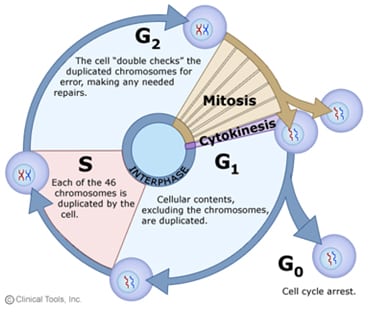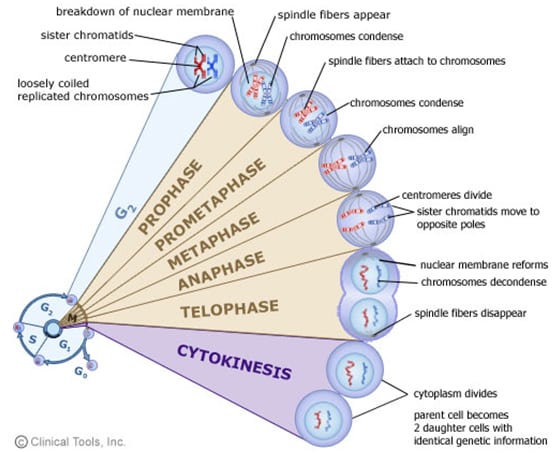Genetic continuity is the transmission of hereditary material through cell division.
The Cell Cycle
– cells do not divide continuously
– in cells capable of dividing, the period between cell divisions is called interphase
– cells spend most of their time in interphase because this is the phase where they perform their functions (obtaining energy, synthesizing products, repair damage, fight disease, duplicate their genetic material and get ready for division)
G1 phase (first gap phase)
– cell grows and prepares to divide
S phase (synthesis phase)
– genetic material is duplicated
G2 phase (second gap phase)
– final preparations for cell division
M phase (mitosis)
– cell undergoes mitosis and cytokinesis
Chromosomes
– are made up of DNA
– formed when DNA coils around special histone proteins
– the long strands of DNA become very condensed and folded (chromosomes)
– made up of two chromatids held together by a centromere
– complete formation during metaphase
Mitosis
-cell division of somatic (body cells) in multicellular organisms
–necessary for the growth and development of multicellular organisms, and repair and the replacement of aging cells
-does not occur at a fixed rate (some cells divide frequently while other cells divide infrequently)
-a parent cell divides to produce two daughter cells; daughter cells are genetically identical to each other
–DNA must be duplicated before mitosis occurs in order to provide each daughter cell with an exact copy of the parental genetic material. This ensures that every new cell will have the same number and kinds of chromosomes as those in every other cell so that each new cell can function properly
Prophase
–centrioles move to the opposite poles of the cell
-chromatin coil into shorter, thicker chromosomes
-replicated chromosomes appear as strands joined at a single point called a centromere (each identical strand is called a chromatid)
-nuclear envelope breaks down and then disappears
-centrioles produce the mitotic spindle fibres and the spindle fibres attach themselves to the chromatids at their centromere (spindle fibres function to move the chromosomes)
Metaphase
– chromosomes line up across the middle of the cell (the metaphase plate)
Anaphase
– chromatids separate at the centromere and each chromatid is pulled towards opposite poles of the cell
Telophase
-nuclear envelope reforms and nucleoli reappear
-chromosomes uncoil, reforming chromatin
Cytokinesis
-cell membrane pinches inward at the middle of the cell, producing a cleavage furrow
-the furrow deepens until two separate daughter cells are formed
a complete set of chromosomes is called the diploid number
-the characteristic diploid number of chromosomes in humans; somatic cells is 46



which phase was most common? why do you believe this is true?
Thanks for the help. I was able to grasp a better understanding, because of this.